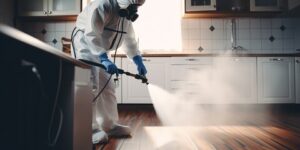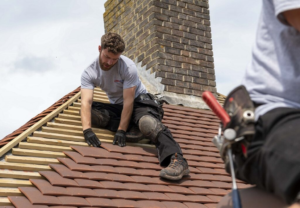Pests can damage crops, contaminate food, and transmit diseases to people. Fortunately, there are many ways to control pests, including biological, physical, and cultural methods.
Biological methods use natural enemies such as parasites and predators to control harmful insects. For example, nematodes (microscopic roundworms) can be sprayed in the soil to kill caterpillars and other pest insects. Click the https://seasidepest.ca/ to learn more.

Pests can cause economic losses by damaging crops and reducing food quality. They can also lead to environmental damage and disrupt ecosystems. They can cause diseases in people and pets and carry harmful bacteria and viruses. Pest control services can help minimize these effects. For example, mosquitoes and ticks can spread diseases like Lyme disease and West Nile virus. Rodents can transmit hantavirus, salmonella, and rat-bite fever. And invasive species such as the Asian long-horn beetle and the spotted lanternfly can destroy forests and disrupt ecosystems.
Pest control methods include prevention, suppression, and eradication. Prevention is the most desirable, but it is difficult to achieve in outdoor environments. It is often replaced by suppression, which reduces pest numbers to an acceptable level. Eradication is more common in indoor environments, such as schools, office buildings, and health care facilities. This method involves destroying an entire pest population.
Effective pest control starts with preventing pests from entering buildings and limiting their ability to reproduce. This can be accomplished by removing their food, water, and shelter. The best way to do this is to keep the house clean and free of clutter. This will limit the breeding ground for pests and prevent them from hiding in cracks and crevices. Regularly cleaning dark, damp areas will also help.
In addition to removing sources of food, water, and shelter, pest control companies may also use physical or mechanical controls. These can include traps, screens, fences, and barriers. Other methods that alter the environment can also be used to control pests, such as radiation and heat. Chemical pesticides are sometimes necessary, but they should be used sparingly and with caution. Using pesticides that are specific to the pest and that target only the insect or rodent will minimize the harm they can cause.
If possible, try to find natural solutions before resorting to chemicals. There are many environmentally friendly pesticides available, and they generally have lower risks than conventional products. However, be aware that not all organic pesticides are effective against all types of insects. Consult a local cooperative extension service office for recommendations appropriate for your area.
Safety
Pests are more than just an annoyance; they can damage your property and cause health problems like asthma and allergies. In addition, they can spread disease and contaminate food. In order to control these pests, you need to hire a pest control company that uses safe methods of extermination and removal. Some of these methods include baits, traps, crack and crevice treatments, and fumigation. In order to minimize exposure to chemicals, always read and follow the pesticide label’s instructions and safety warnings. Also, only use chemicals approved for use in homes. Avoid foggers and bombs, which contain volatile chemicals that can contaminate the air.
Employees should be trained in the safe use of pesticides. This will help them prevent accidents and injuries, which may lead to a loss of productivity. They should be provided with proper clothing and equipment, such as gloves, respirators, and a first-aid kit. Additionally, they should be given information about how to properly store and dispose of pesticides.
Proper hygiene practices are important in pest control work, as it helps prevent the transmission of infectious diseases. Workers should wear gloves, masks, and goggles to protect themselves from contaminated water, insect corpses, and faeces. They should also keep their workspace clean to reduce the risk of contact with pesticide residue and fumes.
Taking measures to control pests can save you money on repairs, reduce your risks of fire and theft, and make your home safer for your family and pets. In addition, you can use environmentally friendly pest control techniques to control pests and maintain your garden or lawn.
Pest control is a team effort, and everyone has a role to play in safe pest management. Building residents can take action by reporting pest control issues to their landlords or maintenance supervisors. They can also inspect their living spaces and seal any openings. For example, they can caulk gaps around doors and windows and fill holes in utility pipes and wires. Additionally, they can remove clutter from their living space to reduce the risk of fires and other hazards.
Reputation
Many pest control companies rely on word of mouth for their business, and online reviews are increasingly important. These reviews can make or break a company’s reputation, and they can have a huge impact on a new customer’s decision to choose a service provider. For this reason, it is essential to build a solid review acquisition strategy. It is also important to prioritize positive reviews, rather than reacting to negative ones.
A pest control technician’s job requires a combination of education, training, and on-the-job experience. Usually, a high school diploma or equivalent is required. In addition, some pest control technicians have a college degree in biology or entomology. Many pest control companies have their own training programs for their employees, which can provide valuable skills and knowledge that can help them advance in the industry. In addition, some pest control companies require their employees to obtain licensure or certification. This is important, as licensing requirements vary by state and can be very strict.
There are several methods used to control pests, including natural, biological, chemical, cultural, and mechanical controls. Natural controls, such as weather or topography, limit the distribution of pest populations by making the environment less suitable for them. Biological controls, such as parasitoids and natural enemies, injure or consume pests to control their numbers. Chemical controls, such as fungicides and herbicides, can control pest populations by inhibiting their growth or killing them. Mechanical and physical controls, such as traps and barriers, limit or prevent pests from accessing buildings and other structures.
When choosing a pest control company, look for one that has a good reputation and offers a variety of services. For example, TERMINIX has excellent customer ratings and an extensive suite of pest-control treatments. It offers one-time, monthly, bi-monthly, and quarterly treatment options. It also has a great money-back guarantee, which is similar to Orkin’s 30-day satisfaction guarantee. It also offers a free reservice if pests return between scheduled visits.
Another important factor to consider is the location of the pest control company. It’s important to find a pest control company that has a strong presence in your area. You can also check if the company has any complaints or problems with the Better Business Bureau. If you see any red flags, you should reconsider hiring that company.
Cost
Pest control companies charge a fee for their services, but this doesn’t mean they don’t offer a good value. In fact, a quality service can be much cheaper than other home improvement options. Moreover, they can give you a warranty that lasts for a year or more. Before you choose a pest control company, make sure you do your research. Look for customer reviews and compare prices. After you’ve done your homework, you should be able to present the client with a quote that includes all of the necessary information.
In most cases, the cost of pest control services is based on the size of the building or house and the type of pests that need to be treated. For example, termite treatments are typically more expensive than cockroach treatments. This is because termites are more difficult to treat than roaches. In addition, they may require fumigation, which is more costly than other methods.
Other factors that affect the cost of pest control are the types of chemicals used and the amount of work required to get rid of the pests. In general, the more labor and materials that are needed to complete a job, the higher the price. For example, a large infestation of bed bugs can be very costly to treat because it requires extensive fumigation.
It’s important to note that prevention is also a significant factor when it comes to pest control. In some cases, a simple solution like caulking a crack or sealing an entry point can drastically reduce the number of pests in a house. This is why it’s important for pest control companies to study their environment carefully before they come up with a treatment plan.
The best pest control companies are known for their experience, safety, and customer service. They are reputable and use licensed professionals who follow safe practices and have extensive training. They are also knowledgeable about the latest pests and have a wide service area. They also provide free estimates and detailed phone consultations to help customers understand the costs of their services.

